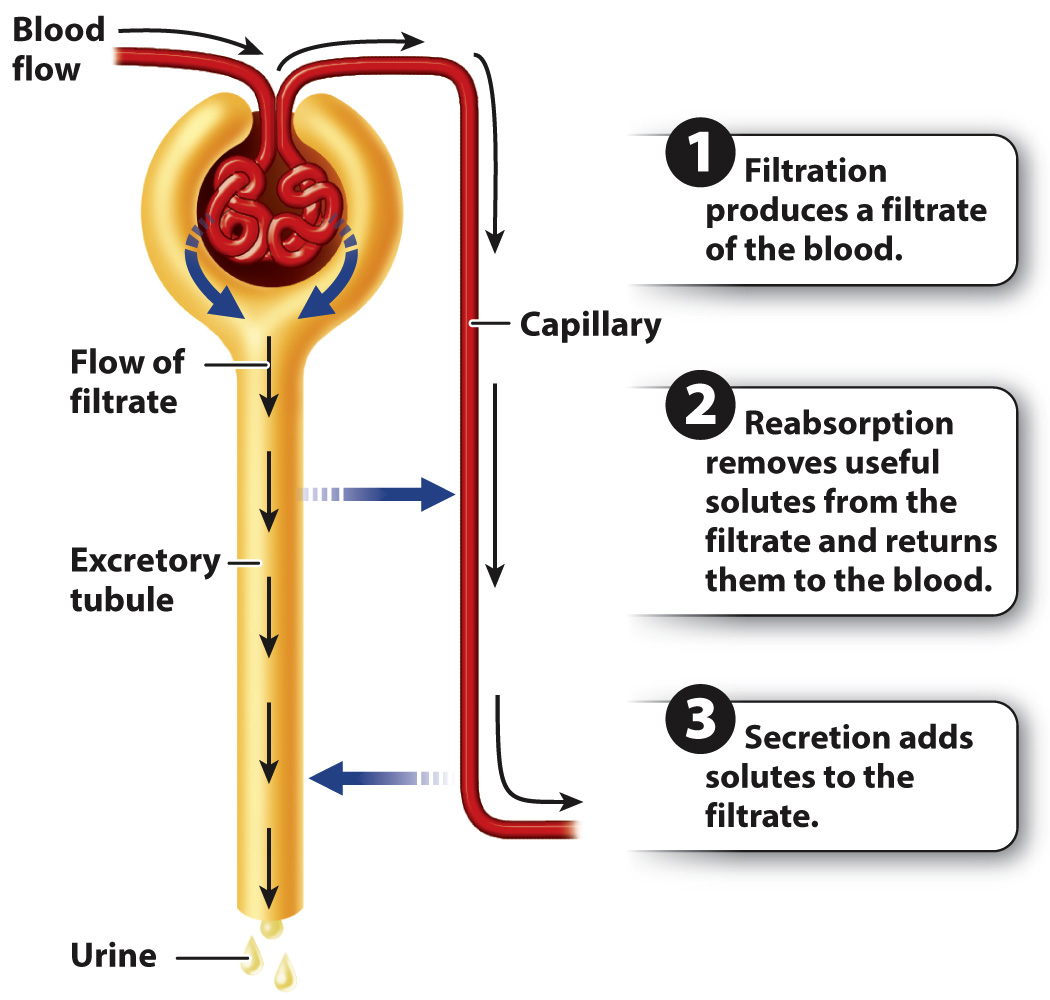Excretory organs work by filtration, reabsorption and secretion.
There are two ways that organisms eliminate waste and other compounds out of the blood: filtration and secretion. Filtration is the process by which the blood is filtered into an extracellular space, allowing some substances to pass through but retaining others. Secretion is the active transport of molecules from the blood into the extracellular space. Filtration is energetically inexpensive and allows removal of novel compounds, but also removes compounds that the body needs, such as water, electrolytes, and essential nutrients. Secretion is specific but energetically expensive. So both are used. Initially, filtration is used to isolate most waste, but because it is nonspecific, reabsorption is required. Reabsorption is the process by which essential molecules are transported back into the blood. Reabsorption and secretion together help to balance water and electrolyte levels, producing dilute or concentrated urine as required by the animal.
The first step of excretion is to isolate the waste into an extracellular space. In the case of unicellular organisms such as Paramecium and simple multicellular animals such as sponges and cnidarians (jellyfish and sea anemones), wastes are isolated in a cellular compartment called a contractile vacuole (Fig. 41.7). Fusion of the contractile vacuole with the cell membrane eliminates the waste contents by exocytosis from the cell (Chapter 5).

883

Multicellular animals with pressurized circulatory systems (annelid worms, mollusks, and vertebrates) isolate wastes from the blood by filtration (Fig. 41.8). Circulatory pressure pushes fluid containing the wastes through specialized filters into an extracellular space. The filtered fluid, called the filtrate, contains waste products along with water, electrolytes, and other solutes. The filtrate drains into excretory tubules that connect to the outside. The excretory filter, like a cell’s plasma membrane, is selectively permeable. It allows smaller ions and solutes to pass into the tubule along with water, but retains larger solutes such as proteins and cells.
Filtration is followed by reabsorption of key ions and solutes from the filtrate into the blood (Fig. 41.8). Reabsorption can be an active process, requiring active transporters for some molecules, or a passive process driven by diffusion for others. In both cases, substances that are needed by the animal, such as electrolytes, amino acids, vitamins, and simple sugars, are taken up by cells of the excretory tubule and returned to the bloodstream. Water is reabsorbed into the cells by osmosis, driven by the osmotic pressure established by the active transport of solutes into the cell.
The final step in waste removal is the secretion of additional toxic compounds and excess ions (Fig. 41.8). Secretion is an active process, involving protein transporters in the plasma membranes of cells lining the tubules. These transporters use the energy of ATP to pump molecules from the blood into the excretory tubules. Secretion eliminates substances that were not filtered from the blood, as well as helps to fine tune electrolyte levels in the blood.
Filtration, reabsorption, and secretion are the three steps that almost all animal excretory systems perform to eliminate toxic wastes, retain essential nutrients, and regulate water and electrolyte levels.